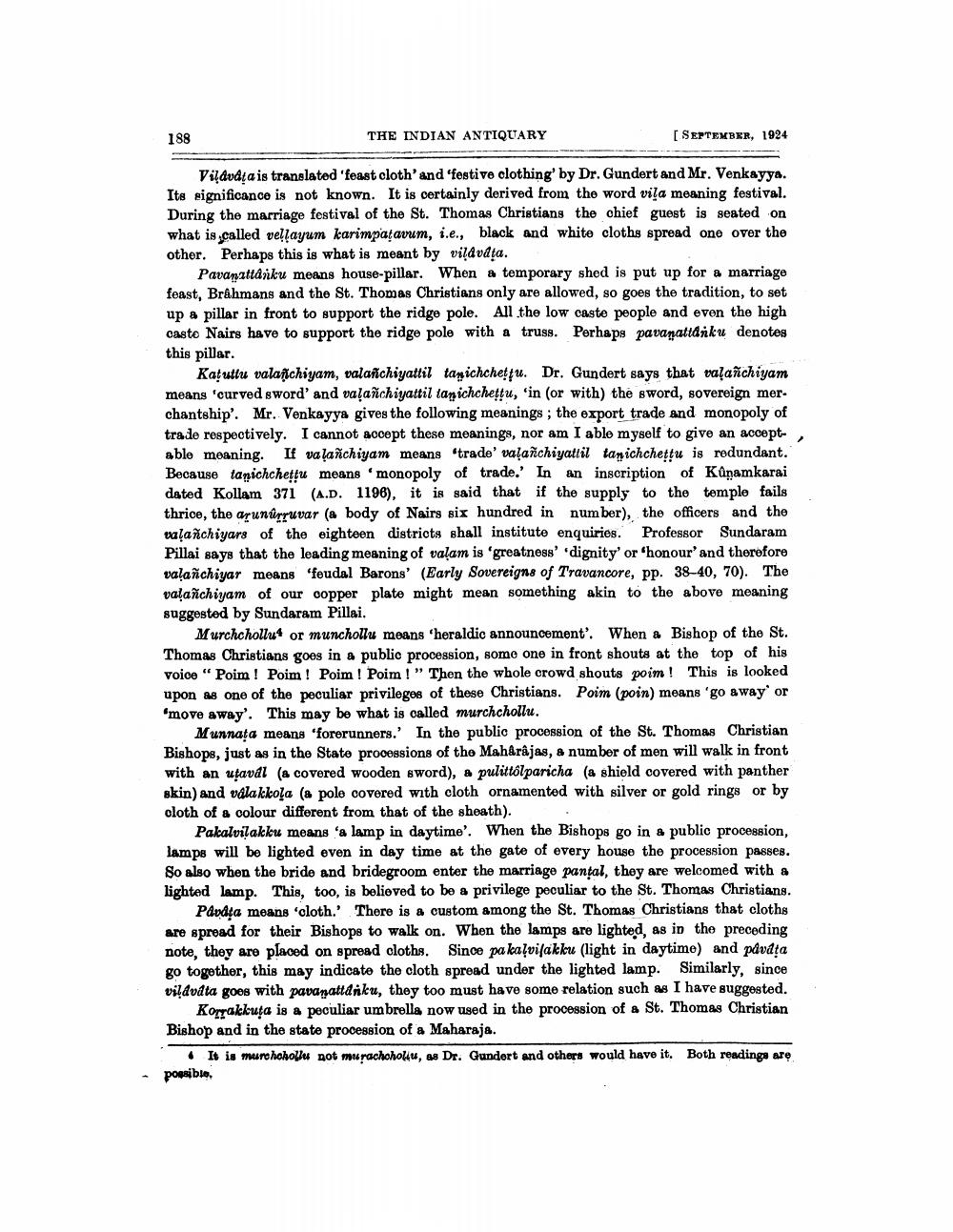________________
188
THE INDIAN ANTIQUARY
[ SEPTEMBER, 1924
Viļavdta is translated 'feast cloth' and 'festive clothing' by Dr. Gundert and Mr. Venkayya. Its significance is not known. It is certainly derived from the word vila meaning festival. During the marriage festival of the St. Thomas Christians the chief guest is seated on what is called vellayum karimpatavum, i.e., black and white cloths spread one over the other. Perhaps this is what is meant by viļdvdta.
Pavanattanku means house-pillar. When a temporary shed is put up for a marriage feast, Brahmans and the St. Thomas Christians only are allowed, so goes the tradition, to set up a pillar in front to support the ridge pole. All the low caste people and even the high casto Nairs have to support the ridge pole with a truss. Perhaps pavanattanku denotes this pillar.
Katuttu valanchiyam, valañchiyattil taxichchetju. Dr. Gundert says that raļañchiyam means 'curved sword' and vaļañchiyattil tanichchettu, 'in (or with) the sword, sovereign merchantship'. Mr. Venkayya gives the following meanings; the export trade and monopoly of trade respectively. I cannot accept these meanings, nor am I able myself to give an acceptable meaning. If valanchiyam means 'trade' valañchiyattil tanichchettu is redundant. Because tanichchettu means 'monopoly of trade.' In an inscription of Kūņamkarai dated Kollam 371 (A.D. 1196), it is said that if the supply to the temple fails thrice, the arunurruvar (a body of Nairs six hundred in number), the officers and the valanchiyars of the eighteen districts shall institute enquiries. Professor Sundaram Pillai says that the leading meaning of valam is 'greatness' 'dignity' or 'honour' and therefore valanchiyar means 'foudal Barons' (Early Sovereigns of Travancore, pp. 38-40, 70). The vaļañchiyam of our copper plate might mean something akin to the above meaning suggested by Sundaram Pillai.
Murchchollut or munchollu means "heraldic announcement'. When a Bishop of the St. Thomas Christians goes in a public procession, some one in front shouts at the top of his voice “ Poim! Poim! Poim ! Poim!" Then the whole crowd shouts poim! This is looked upon as one of the peculiar privileges of these Christians. Poim (poin) means 'go away or 'move away'. This may be what is called murchchollu.
Munnața means 'forerunners. In the public procession of the St. Thomas Christian Bishops, just as in the State processions of the Mahârâjas, & number of men will walk in front with an utavdl (covered wooden sword), a pulittólparicha (a shield covered with panther skin) and valakkola (a pole covered with cloth ornamented with silver or gold rings or by oloth of a colour different from that of the sheath).
Pakalvilakku means 'a lamp in daytime'. When the Bishops go in a public procession, lamps will be lighted even in day time at the gate of every house the procession passes. So also when the bride and bridegroom enter the marriage pantal, they are welcomed with a lighted lamp. This, too, is believed to be a privilege peculiar to the St. Thomas Christians.
Pavdta means 'oloth. There is a custom among the St. Thomas Christians that cloths are spread for their Bishops to walk on. When the lamps are lighted, as in the preceding note, they are placed on spread cloths. Since pa kaļvilakku (light in daytime) and pdvdta go together, this may indicate the cloth spread under the lighted lamp. Similarly, since vildvdta goes with pavaşattaniku, they too must have some relation such as I have suggested.
Korrakkuga is a peculiar umbrella now used in the procession of a St. Thomas Christian Bishop and in the state procession of a Maharaja.
It is murehohollu not murachoholiu, as Dr. Gundert and others would have it. Both readings are possible,




